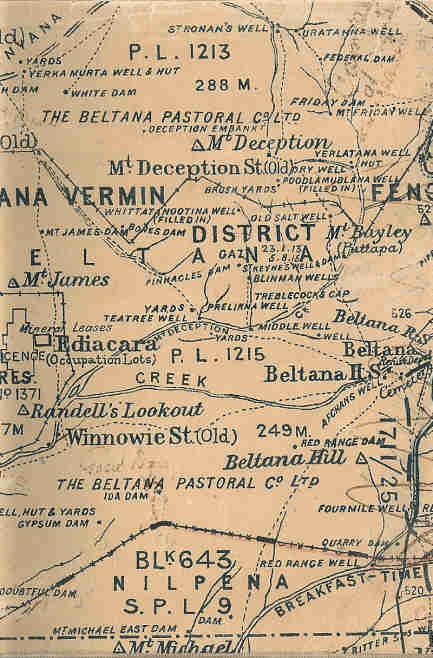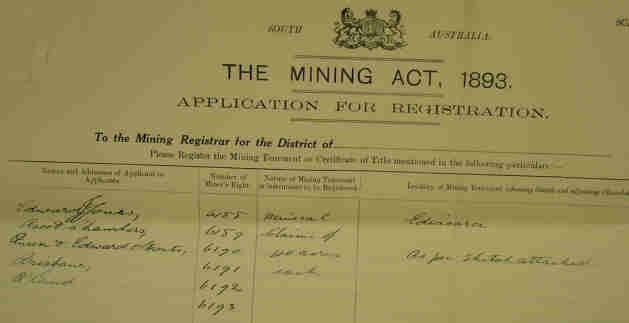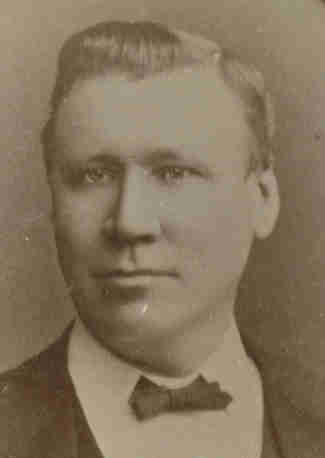


|
|
South Australia's Mining Industry.Silver mining (part 2)
Many businesses in Beltana looked after the miners' needs on the silver fields. At the same time it could be argued that directly and indirectly silver mining contributed to the expansion and economic progress of Beltana and its residents. With the many mines opening up around the town several of the miners took up residency in Beltana. Those who lived on the mining sites, and many did, still ordered most of their supplies from the town. One of the local businessmen lost no time to advertise his business as C.R. Shepherd and Co. Carpenters and Builders, Cabinet Makers, have commenced business at Beltana and Winnowie and are prepared to contract for any kind of Building or Carpentering work. A Stock of Timber, Galvanized Iron, Ridgecapping, Palings, Bricks and other Building Materials always on hand. Mining Companies will save money by engaging us to do their work. It did not take too long before the residents of Beltana had a petition organized to be presented to the Minister of Mines, asking that smelters be erected at their town, rather than anywhere else. They argued that: with the Sliding Rock to the east, the Ediacara and others to the south, and the numerous copper mines all round the district, smelters should pay handsomely, besides helping to develop the mineral resources of the north and give employment to hundreds of men... Without a doubt this northern country will in time become a great mineral producing country. During February several more silver mining companies were incorporated to mine the Ediacara, Winnowie and Wirrialpa fields. One of these was the Mabel Silver Mining and Prospecting Syndicate with a capital of $1,000. It had dug a tunnel for a distance of twenty metres but had not been able to locate any silver. Another one was the Mabel Extended Silver Mining Company with a capital of $1,400, four mineral leases, and an office at Melvin Chambers King William Street Adelaide. After two months of digging in the shimmering heat of nearby Lake Torrens, only two men remained at the mine, but no lode or vein had been located as yet. The Great Extended Beltana Silver Mining Company with a capital of $20,000 was to work claims number 11,830 - 11,837 and claim number 11,901. It was incorporated on 21 February 1888. Its claims had previously belonged to Charles William Litchfield of Coombah, New South Wales. The promoters of the Great Extended were Adelaide based, with ninety-eight percent of the shareholders also coming from there. Not one single share was taken up by residents of the Northern Flinders Ranges. The life of the Great Extended was very short. On 29 October, eight months after its incorporation, it was wound up again. The Beltana Broken Hill Proprietary Silver Mining Company, incorporated on 21 February 1888, did much better. This company had four mineral claims on the Ediacara field, which it had bought from the Broken Hill Miners Prospecting Syndicate. The promoters were also from Adelaide, but its shareholders came from Broken Hill, Silverton, Adelaide and a good number of places from the Northern Flinders Ranges. Among this group were John Gibbs who took out 500 shares, E.H. Blewett 125, F.M. Buttfield 15, J. Dobson five and H. Shepherd 45 shares. All of them lived in Beltana. Farina residents also bought into this company. Among them were J.J. Doig who had acquired 240 shares, A.S. Lewis 120, J. Napier 105 and P. Provan had bought ten shares. Miners on the Winnowie field were also convinced that this was something special. Several of them had small parcels of shares, in particular J. Cuttmore who held two, John Jenkins five, M. Eddy five, J. Richards twenty and E. Curtis fifty-five. The Beltana Broken Hill Silver Mining Company, perhaps more than any other, represented South Australia's hope of having its own Broken Hill. Captain Lewis and his men had already undertaken extensive exploratory work on the property. Several shafts and some drives had been completed and enough ore exposed to enable Captain Lewis, when handing in his first report to the Board of Directors of the Beltana Broken Hill Silver Mining company to say that 'After careful examination of the lode itself and its surrounding strata I have come to the conclusion that the lode in your property is of sedimentary origin, and that it will be found to extend over the whole of your property... From the recent tunnel, as I understand, the 5 tons of ore obtained was taken to Dry Creek Smelting Works, the return from which (32oz.), if it can be maintained... will render yours a very valuable and dividend paying mine judging from the economical manner in which it can be worked'. Captain Lewis also explained that he intended to put in another tunnel into the hill which would be large enough to use a horse to 'facilitate the removal of the ore'. Apparently he was successful in his attempts as large quantities of good ore were obtained soon afterwards. Captain Lewis now planned to build a furnace for the purpose of assaying the ore. Soon there were still more companies which hoped for the same good results as those of the Beltana Broken Hill and the Ediacara Silver Mining companies. The Winnowie Consolidated Silver Mining Company Ltd., with a capital of $200,000 hoped to work its ten claims at Winnowie. But during April 1888, Captain Bennett had only two men working on one of the company's claims. Naturally they were employed on that claim which adjoined the Ediacara claims in the hope that their lode would extend into their own property. After four weeks work it seemed that their gamble had paid off. They were coming across some very rich ore. Unfortunately the men had to leave it, as the blasting material needed to remove it, had not yet arrived on the field. The Flinders Silver Mining Company Ltd was a more modest affair. It had issued one hundred shares to the value of $20 each to work a claim at the old Wirrialpa Station. The Wepowie and Niltibury Silver Mining Syndicate had ten claims on the Moolooloo run which they hoped to open up with a capital of $4,000.
The Victoria Mint Silver Mining Company Ltd, with a claim at Mount Serle, next to the Imperial Mint Silver Company, hoped to raise $8,000 with the issue of two hundred $40 shares. Another company with claims at Mount Serle was the Beltana Comstock Silver Lead Mining Company N.L. The Mount Roebuck Silver Mining Company Ltd had two claims, numbered 10,972 and 10,973 at Blinman, an office at Melvin Chambers, King William Street Adelaide and five directors, including P Sando and T Scherk. The Beltana South Silver Mining Company had two claims at Beltana next to those of the Beltana Broken Hill and had high hopes of being able to raise $120,000 to work them. Many other silver mining companies had "Beltana" as part of their name. There were the Beltana King, Beltana Edith, Beltana Winnowie, Beltana Wheal Terrell, Adelaide Beltana and the Beltana North Silver Mining Company. Finally there was the Centennial Silver Mining Company Ltd with an office at Beltana and four mineral claims of Trebilcock's Gap, where silver, copper and gold had been found. One of its directors was F.M. Buttfield also of Beltana.
The Black Range Blocks Silver and Copper Mining Syndicate, with a capital of $1,000 had four hundred acres at Blackfellows Creek and found little copper but no silver. The Great Winnowie Central Silver Mining Company Ltd with $100,000 and two claims at Ediacara had among its directors J.W. Downer, L. Scammell, W. Milne, H.W. Hughes and L.A. Jessop. Unfortunately a large number of parliamentarians on the board of directors did not necessarily mean that large amounts of silver would be found. At times one could be forgiven for thinking that there would be no more land left to stake a mineral claim on. During the first two weeks of March 1888 more than 450 mineral application were made for sections in the Northern Flinders Ranges. Many familiar names appeared time and again on the application forms, for instance E.H. Blewett, A. and E. Bralla T.C. Cotter, C.M. and S.C. Hantke, C. Mottram, Edith Gason, E. and A. Hantke, F.M. and Helen Buttfield, Leslie Buttfield, A. Braddock, Anna and Marion Doig, Victor Hantke and James and Michael Darmody. All these claims and mines needed huge amounts of timber. It was used for the miners' personal fires, their huts, timbering of shafts and drives, but most of all for the boilers and furnaces. As it turned out, there seemed to be both enough land and timber to satisfy everybody's demand. However on 4 March Corporal Richards of the Beltana police station asked his superiors in Port Augusta to supply him with 'Bills or Placards, warning people against cutting gum timber in the neighbourhood of the Winnowie mines'. Obviously he was concerned with the rapid destruction of this natural resource, which was also against the law. Land to peg out mineral claims was still available though. There was even land available which was supposed to contain silver. As late as June 1888 the Mount James Consolidated Silver Mining Company Ltd. was formed to work the nine claims it had bought from Frederick Hayward. These claims were situated near Mount James, north of the Ediacara silver field. Most of the shareholders in this venture were from Adelaide. Only two residents, A.E. Russell and Jason A. O'Brien, both of Marree, showed enough faith in it to be persuaded to buy shares in this company. Just as well, as six months later the company had ceased to exist. The Mount James Consolidated was incorporated at a time when silvermania and its excessive speculation on both the Adelaide Stock Exchange and on the silver fields had run their course, for more than one reason. During July 1888 it was reported from Beltana that 'The silver boom being over, the gold fever has broken out, and the excitement is immense. The new discovery is about 25 miles north of here and it is reported that there are about 50 men now there, many of whom are finding gold. However, I would advise anyone in work to be very cautious about leaving for the field until the value of the find is proved. At present it is confined to a very limited extent of country. The silver mines are being deserted for the gold fields, and all operations will have to be suspended, I expect, for the present. There is one store open on the gold field already, and before Wednesday there will be three, and one, if not two, butchers will be at work. Wood is plentiful, and water can be got by carting a few miles'. As usual not everyone believed that the silverboom was over. The very day the above report was written the Puttapa Mining Company Ltd. was formed with an office in Beltana and a proposed capital of $4,000. It had five claims, about twelve kilometres north of Beltana. Some reports were still hopeful and even encouraging, particularly as most mines on the Ediacara field and the Winnowie field were still yielding good quality and quantity ore. At the Ediacara mine there were still four hundred bags of ore at grass awaiting transport. The company later had some twenty tons of ore sent to Germany for treatment.  By September though most of the mining news of the Northern Flinders Ranges had disappeared from the newspapers. From now on most of the news which was printed was mainly bad news. On 20 October 1888 the Beltana-Winnowie Silver Mining Syndicate held a shareholders' meeting at Beltana. The news which they were given was decidedly bad. The men who had been working their mine were discharged, Mr Hantke, one of the directors resigned and all work was to be stopped. Other companies tried to call in money on unpaid calls under threat of forfeiting the shares. Others tried to restructure their companies in an effort to stay afloat. On 14 November 1889 the Ediacara Silver Mining Company Ltd. for example became the New Ediacara Silver Mining Company N.L.48 This time it hoped to raise a capital of $160,000 with the issue of 16,000 shares of $10 each. Most companies, like the Great Comstock were just wound up. With mining activity slowly decreasing, the demand for firewood also decreased. Even so Mr Goyder still found it necessary to remind the police at Beltana and other mining towns 'to take every precaution to prevent the holders of licences or others from cutting or destroying sandalwood and to prosecute same with the utmost rigor of the law'. During January 1890 the New Ediacara mine was inspected by two of the company's directors from Adelaide. They made a minute inspection of both the underground and surface workings. At the conclusion of their visit they both expressed satisfaction with the progress and prospects of their mine, including the site fixed for the concentration plant, capable of treating ten tons per day. The carpenters at the mine had nearly finished the substantial five-roomed house to be used for the residence of the mine manager and as his office. His old house was to be converted into a blacksmith and carpenters' shop. Underground, at a depth of about seventeen metres, a winze had been erected, and from both the stopes and shafts a fair quantity of ore had already been raised, some of it by old ex-Burra miners.
Most of the mining materials had finally arrived at the mine, after being held up because of heavy rains, which had resulted in the Winnowie Creek running a banker for two days and making the roads impassable for some more days. However the sixty or so millimetres of rain had replenished the well which supplied the miners with badly needed fresh drinking water. With prospects continually improving at the New Ediacara mine, the government had even sent Mr Irvine, Inspector of Roads, to the field to see how the road between the mine and Beltana could be improved and shortened. The need for this was made abundantly clear when a few days later Captain Truscott and his son, on their way back from Beltana to the mine, finished up in the Sundown Creek, and Mr P. Kaine, the mailman, was nearly washed away with his horse and the mail in another creek.
*** If you would like to find out more,
|





